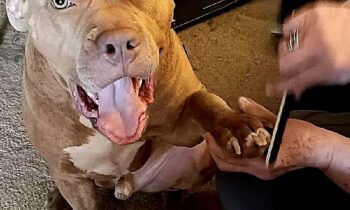
Bratty barking—what is it? Bratty barking is the term I use for my own dog’s demand barking. When he barks because he wants something, that’s demand barking—he’s demanding what he wants.
Demand barking is different from, say, alert barking—the barking your dog does when he sees someone approaching your home, for example. The postal carrier is on your porch, your dog barks to alert you to that intrusion. A car parks in front of your house, your dog barks. He’s saying: “Alert, alert! Approach imminent! Warning! Warning!” That sort of barking is usually helpful to you, as long as it does not continue for too long after the threat has passed.
Barking while playing, either with you or with other dogs, is also quite normal. For dogs with herding in their mixes, there may be a combination of chasing and barking—Scout chases other dogs, barking at them as they run away. Scout may also bark when a human moves quickly, then follow that human, announcing to all, “He’s moving, he’s moving, I’m right on his heels.” Again, in small amounts, play barking and herding-style alert barking may be perfectly acceptable in most situations. It’s only when the duration of the barking episode continues much too long that humans become agitated.
Bratty barking—demand barking—is different.
I’ve been getting bratty barking from my youngest dog almost since the day we met. He was a stray, picked up by animal control—no leash, no collar, no microchip, no ID. He was an adolescent, not neutered. He may have been on the streets for a while. No owners came to claim him. He had been adopted and returned within days because he was “too active.” I thought that was a point in his favor, although I’ve come to reconsider that thought many times since. He’s a big, physical dog, with very few fears. He’s quite willing to pursue what he wants in any way that he can.
Bratty barking because he wanted out of his crate was easy to deal with—I simply refused to let him out of the crate until he was silent. Even with a grown dog, you do the same thing you’d do with a puppy. If a puppy is crying to get out of his kennel, the last thing you want him to learn is that crying to get out of the kennel works! You never let a puppy out of his kennel until he is silent, even if it’s silence for just one second. The puppy is never rewarded (given what he wants) for noise in the crate.
Bratty barking because he wanted to go outside was also easily stopped—I simply would not open the back door until he was silent. I still get occasional excitement barks from him as I open the door, but since I’ve been known to shut that door instantly with him still on the wrong side, the now-and-then barks—“Whoopee, outside! Let’s party!”—are infrequent and mild. (I do not expect my dogs to indicate with barks when they need to go outside to potty. Instead, they come to me and each gives his or her own patented display that indicates, “Gotta go, gotta go, gotta go NOW!” I always pay attention.)
Bratty barking for treats? Nope, not on my watch! I can stand there with treats in my hand and, if one dog barks inappropriately—in this case, barks at all if not cued to bark—the others get treats but he or she does not. This simple but effective method works well with just one dog, too. You stand there with treats in your hand and, if your dog barks, you put the treats back in the cupboard and walk away. Words are not necessary. Your message to the dog is clear: barking equals no treats.

Bratty barking for meals, however, seemed much less simple for me to solve. In the first place, I have three dogs. Two of them, now both twelve years of age, have never barked for meals. I try to feed meals—breakfast and dinner—at relatively regular times. They all eat in the same room, the kitchen. Initially, the third dog, as a newcomer to the household, was fed in his kennel, for the security and serenity of all concerned, including me. As I got to know him better, I was able to feed the newcomer in the kitchen, too, with his bowl on the other side of the room from the feeding stations for my other two. In the beginning stages of that transition, he was on a leash while eating, but he soon earned his way to unleashed eating. (I still watch him closely, as he’s prone to pushing my five-pounder away from her bowl and eating what remains of her dinner.)
I can’t explain how the bratty barking crept up on me, but it did. I let it. It was my fault, of course. The dog is a dog—he’s not plotting to overthrow the government, he’s just trying to hurry up dinner. The bratty barking became so extreme that mealtimes were a nightmare. I failed him and I failed myself by responding not as a dog trainer but as a typical owner: I got mad! I yelled at him. Yes, I did. Of course, we all know that I was really mad at myself, but instead of hitting my own head with a rolled-up newspaper, I took the easy way out: I blamed the dog. It was his fault, he was an idiot!
No, he wasn’t an idiot. While he may not have been speeding up service at the doggy diner, he was getting an enormous amount of attention for his inappropriate behavior. It may actually have seemed to him that I was egging him on, encouraging him, barking right along with him. If you were a dog, what would you have thought? Not, “This woman is crazy.” Probably: “She still feeds me.” In doggy terms, that’s good enough! Plus the silly dog was getting himself “high” from all that barking, rewarding his own behavior by reducing his own anxiety. It’s a vicious circle, folks!
Finally, I got mad at myself. I stopped taking it out on the dog. I taught him an alternative behavior. I taught him to “stay” while I prepared doggy meals. “Stay” in my vocabulary, the one I want the dogs to learn, means remain in position until you’re released, no movement (breathing allowed!), no vocalizations. I chose to have him “stay” in a down position, as it would be more comfortable and easier for him to maintain as I added seconds, then minutes, to the length of the exercise.
That all went very well. He had already learned to “wait” as I put his bowl down for a release cue (“Okay!”) to eat, so some foundation was there. Eventually, he succeeded in doing a down/stay across the room from his food, then out in the hall where he couldn’t even see his food. I always returned to his side to release him. Upon his release, he galloped to his bowl and ate.
His stays got very good, at least in the hall and kitchen. He didn’t bark because he was busy staying, a behavior which includes not vocalizing. I was delighted! I was thrilled! Mealtimes became so much more peaceful, so very quiet. All I heard before the bowls went down was breathing. I had succeeded in outwitting the bratty barker!
Apparently, I decided to rest on my laurels because you know what? It didn’t last. He got quiet and I got cocky. “He knows it now! My work is done!” Fat chance. I won’t say the bratty barking returned before I knew it because I certainly knew it. But my non-trainery instincts so wanted to believe it was over for good. He would whine a little while waiting for dinner, not on a stay, just lying down of his own accord—his own choice. I would give him a dirty look and he would stop whining. See, I would tell myself, he knows what’s expected, he just slipped up a little. Within weeks, I was again yelling at him, even madder now because, dammit, he knew better!
He didn’t.
He knew that his vocalization and bratty barking was again getting him attention. I might actually have been serving doggy dinners faster because I was angry. His barking may well have sped up the process of getting food into his mouth. For sure, he was being rewarded.
I am a dunce.
I had to stop being a dunce and start being a trainer.
I had to stop getting mad, at him or at myself.
I had to take the emotion out of the process.
I set some firm rules for myself and I followed them.
The dogs go outside just before each meal. When they come back inside, into the kitchen where they eat, I have their meals (in containers, because I soak their kibble) on the counter. I wait for hot water, pour that into the containers to warm their meal up, shake that around a little, then pour the food into their bowls. If at any time during that process the dog makes a sound, I stop.
I go to the bratty vocalizer, take him by the collar, and walk him into a kennel that is just outside the kitchen door, maybe ten feet away. Once he is in the kennel, I ignore him. The two other dogs are served their meals and cued that it’s okay to eat. Regardless of what the bratty barker is doing, they are eating on time and in some semblance of order. True, they have to put up with his loud objections, but frankly, the noise hasn’t seemed to deter them at all. They eat and go outside.
The bratty barker stays in his kennel until he gets quiet, no matter how long that takes. At first, I counted seconds of “no bark” when he was quiet. Five seconds of no noise got him out and to his food bowl. I waited a darn long time for five seconds of quiet, let me tell you. That boy was ticked! He howled.
My dog has an inner diva—he’s a doggy opera singer, I swear. He perfected his arias as I stuck to my rules. It took a long time. It got worse before it got better. There’s a scientific term for what he went through—it’s called an extinction burst. He barked more before he barked less . . . lots more.
It was painful, I admit it. But I stuck to my rules. I didn’t get emotional, I let the extinction burst run its course, and I covered my ears. One night, he barked for so long that the other dogs had time to finish dinner, go outside, come back in, get treats, go upstairs, and settle down with me to watch TV. I was still “counting” under my breath but there were simply no pauses—the opera was ceaseless. That night, I finally snuck downstairs to find him asleep in the kennel. I let him out and fed him.
That night was the worst.
It got better after that.
It’s been weeks since that night.
Long story short, he’s now silent before meals. He often puts himself into a down. Every now and then, I can see his head come up, his muzzle raise, poised to bark . . . and he stops himself. His head goes down between his paws, and I swear I can hear him thinking, “Not now, not now!”
He’s learned self-control.
At that time, in that place.
My neighbors will tell you that he still barks outside the back door to come in. Obviously, I have a lot more to accomplish with this dog, including teaching him to sing in tune. I’ll work on the door barking next, as a favor to everyone who lives nearby. I will follow my own rules. I will not get mad.
I hope.



